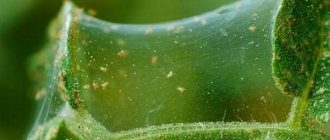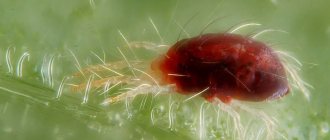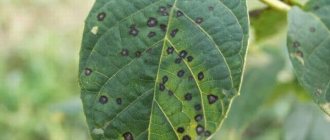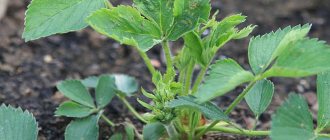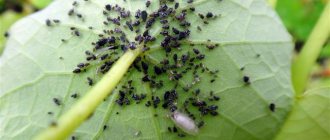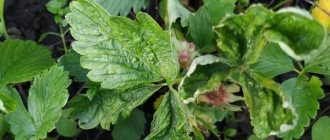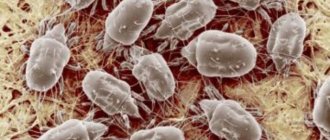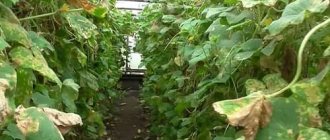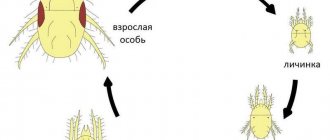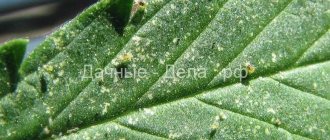Growing eggplants is a labor-intensive task, they are famous for their tenderness and capriciousness, are often susceptible to disease, and pests are especially fond of them. Therefore, the appearance of a spider mite on eggplants, this small insect sucking juice from the leaves, is, although not the only, but a dangerous problem that threatens the rapid death of a young vegetable.
Removing spider mites that have settled on eggplants is not an easy task, since the life cycle of these arachnid green “gourmets” is quite short, and several generations that have changed during the season can get used to one type of poison that was used to treat vegetables in the past.
The spider mite requires you to immediately begin to fight it, both in the greenhouse and in the open ground, also because if it multiplies quickly on your favorite eggplants, other crops planted in the neighborhood may also suffer, because its “menu” includes more 200 plants.
Signs of spider mites
Chemicals
The fastest way to destroy spider mites is to use chemicals that can be purchased in specialized stores.
When using them, it is important to carefully read the instructions for use so as not to harm the plant even more. Let's look at the most common chemicals that can be used to treat a plant.
- Colloidal sulfur. This substance is used to spray bushes. After just three days of regular procedures, the ticks will completely die. To prepare a working solution, you need to dissolve 40 grams of sulfur in five liters of water. Treatment with this product should not be carried out during the flowering period of the plant and a few days before harvesting.
- “Bitoxibacillin.” You can purchase the product in a specialized store in powder form. 100 grams of the drug should be diluted in a bucket of water and sprayed on eggplant bushes before or during flowering. Treatment is stopped a week before harvest. After 3-5 days of regular spraying, the parasite will die. You can re-treat in a week.
- “Fitoverm”. The main active ingredient of the drug is aversectin, which paralyzes insects. However, its effect does not apply to pest eggs, which is why it is necessary to re-treat. After 3-6 days, paralyzed ticks will begin to die. The effect of the substance remains on the bushes for 20 days after treatment.
- "Aktellik". This drug is fast-acting, because the parasites begin to die instantly. It is necessary to spray eggplants with the product in dry weather at a temperature of +12…+25 degrees. To prepare a solution, 1 ml of the drug is diluted in 1 liter of water. The resulting liquid is enough to return to an area of 10 square meters.
- “Anti-mite” is a product designed to combat spider mites specifically on agricultural crops.
Penetrating into the body of the parasite, the poison begins to infect its insides with toxins and kills the spider. If all rules of use are followed, the drug is completely safe for plants and humans. After treating the plants, the effect of the substance lasts up to 10 days. However, you should not use the drug near apiaries and ponds, as its toxins can be dangerous to bees and aquatic inhabitants.
Prevention measures
In order to prevent the appearance of spider mites on eggplants, it is necessary to adhere to the following preventive measures:
- ventilate greenhouses and greenhouses;
- for preventive purposes, treat bushes using folk or biological means;
- increase humidity by spraying;
- on hot days, constantly water the eggplants;
- loosen the soil;
- inspect bushes for the presence of parasites.
Aphids and the Colorado potato beetle cause no less damage to the plant. We also recommend that you familiarize yourself with the causes of diseases of eggplant leaves and methods of treating them.
In addition, after harvesting, the beds must be dug up, the remains of old bushes must be removed, and the greenhouse must be treated with disinfectants. Spider mites are parasites that can destroy eggplants in a short time. That is why it is so important to start destroying it at the first sign of its manifestation.
How to deal with spider mites in the garden
Spider mites on cucumbers
The presence of spider mites on cucumbers can be determined by white puncture spots and light, thin webs. With severe damage, the leaves turn white completely. Pests accumulate on the leaves and shoots of the plant. How to treat cucumbers against spider mites? You can start fighting the pest by spraying with warm water with laundry soap dissolved in it, but before that, severely damaged leaves must be removed from the cucumbers and burned, preventing the proliferation and spread of spider mites to other plants. It is better to completely destroy cucumber bushes that are infested with ticks.
To create conditions unbearable for mites, on a cloudy day, water the garden bed generously, then immediately cover it with film: under the cover, the air humidity will become very high, and this will greatly harm spider mites.
If the damage is significant, the cucumbers will have to be treated with acaricides. However, the appearance of ticks in a bed of cucumbers can be prevented if you change the area for the crop every year, plant the bushes according to a scheme developed by specialists, without thickening the planting, and in the fall, remove all plant debris from the bed and dig up the soil.
Spider mite on pepper
Peppers are mainly parasitized by tetranych mites. From their punctures, a characteristic marbling is formed on the leaves. Spider mites settle on pepper seedlings and adult plants. Over time, the puncture points merge, and the affected leaves turn brown. As mites move through the plant, they leave webs on the leaves and stems. Heavily webbed plants dry out because their photosynthesis and transpiration rates are reduced. The loss of pepper yield due to severe spider mite infestation can reach 60%. As with other plants, favorable conditions for spider mites to appear on peppers include dry air, dehydration of plant tissues, and too high levels of nitrogen in the soil.
The fight against spider mites on peppers is carried out in all possible ways: removing the affected leaves, and sometimes the entire plant, spraying with water, insecticidal infusions and decoctions in the evenings, and also, in case of severe occupation, treating the pepper with chemicals. Among the folk remedies, washing plants with a soap solution (a bar of laundry soap per 10 liters of water), spraying with 96% alcohol, a decoction of black henbane, tobacco or an infusion of garlic are effective. Of the acaricides, the most effective are Kleschevit, Apollo, Akarin, Actellik and Dicofol 20%.
Spider mites on eggplants
A spider mite that has settled on eggplants can cause colossal losses, since it can destroy the entire crop in two weeks. And if you do not take measures to destroy it, then, after overwintering in the soil, the pest in the spring will take up the destruction of next year’s crop with renewed vigor.
As soon as you notice discolored spots on your eggplant leaves, start dealing with mites immediately. By what means to do this is up to you. If there are few ticks, you can start with folk remedies that are less toxic to humans or use a biological method: introduce predatory Amblyseius or Phytoseiulus mites, which can be purchased at garden centers, into the garden bed. But if there are a lot of pests, do not waste time and immediately start treating eggplants with acaricides.
Spider mites on tomatoes
Having appeared on tomatoes, spider mites bite through the leaf plates, as a result of which they turn yellow and dry out. As a preventative measure, it is necessary to regularly weed the beds and remove damaged leaves and shoots from the bushes. The fight against pests on tomatoes begins with the use of folk remedies, and it is necessary to resort to acaricides only if treating tomatoes with decoctions and infusions does not produce results.
What folk remedies help get rid of mites on tomatoes? Soap solution (1:6), two percent bleach solution, medical alcohol, black henbane infusion. Of the chemical preparations, it is better to use Plant-Pin, Fitoverm, Actellik, Etisso, Apollo, Aktaru, Antiklesch or Fufanon.
Signs of defeat
You can save eggplants if you pay attention to their condition in time: external signs of infection with an infectious disease appear, and even before the fruits appear, the condition of the leaves deteriorates.
Moreover, the symptoms of ticks
differ on young and mature plants.
Signs of seedling damage
Eggplants at the initial stage of development are more susceptible to infection, since they have weaker immunity than adult plants. As a result, the seedlings stop developing. Signs of a lack of nutrients appear due to the fact that mites suck out the juice. The leaves wither and fall off. These are the main signs of damage to young plants; usually such changes become visible soon after eggplant infection. Measures are immediately taken to treat the bushes, so the web does not have time to form.
If eggplant seedlings are infected with spider mites, you need to take immediate action.
Signs of damage to adult fetuses
When eggplants grow, slightly different signs appear when they are affected by mites:
- light dots on top of leaves;
- pigmentation – brown spots appear when there are too many punctures;
- marble pattern on the leaves - this effect is ensured as the number of the colony increases;
- leaves are deformed;
- with severe infection, the bush begins to dry out, first the condition of the top worsens;
- the number of ovaries decreases, and those that appear are deformed and small in size;
- When mites appear on eggplants in a greenhouse, a cobweb is always found on the plants, but it can be seen in case of severe infestation; at the initial stage, the cobweb is not visible.
Spider mite on cucumbers: who is it?
The sooner you detect a mite on cucumbers, the higher the likelihood of saving the crop. Therefore, you need to know well what danger looks like and inspect the leaves in the garden as often as possible. Therefore, a summer resident who visits the site only on weekends runs a significant risk of losing a full harvest.
The danger of spider mites
Only a gardener with excellent eyesight can carefully examine a tick: it is a very small insect, no more than 0.5 mm in size, colored brownish-red. With magnification, you can easily see four pairs of legs (while the insect is in the larval stage - three). The larvae are greenish in color, turning brown on the sides.
With magnification, you can examine the tick in detail; the bottom part of the figure shows the results of his activities
Ticks overwinter in the soil, crawling to the beds with the onset of warmth and the appearance of enough greenery to feed them. In summer, insects prefer hot weather without precipitation. Females lay about a hundred eggs at a time, giving about 20 generations over the summer. The larvae hatch very quickly, within a few days. The most favorable conditions for tick reproduction are a temperature of about 30 ° C and a humidity of about 60%.
On cucumbers, the mite prefers to settle on the underside of the leaves, where it sucks the juices from the plants, piercing the leaf pulp. Gradually moves to the stems, and then to the emerging fruits, causing enormous damage. The upper areas of cucumber plants are most affected. A dense web entangles both stems and leaves, disrupting oxygen exchange and suppressing photosynthesis. Productivity is significantly reduced: at best, almost halved.
The web covers the entire plant, but it is not very similar to the web that the well-known house spider weaves
Cucumbers are especially comfortable in a greenhouse, since it creates ideal conditions for its life and reproduction:
- sufficient heat;
- protection from wind and rain;
- absence of tick-eating birds and large insects.
The tick changes its location with the help of scraps of the web it creates. “Relocation” is also possible with the participation of humans or animals, as well as weeds. It is impossible to completely protect plantings from ticks: they can fly in from anywhere with gusts of wind or “arrive” on any animals.
Signs of spider mite damage to cucumbers
It is not always possible to quickly detect the insect itself; More often than not, the consequences of his sabotage are discovered first. They might look like this:
- light dots on the underside of leaves, turning into merging spots;
- a barely noticeable, almost transparent milky-white web entangling the entire plant;
- slowing down the growth of cucumber vines;
- yellowing or browning of foliage followed by drying out.
Of course, yellowing of the leaves is also characteristic of many diseases, as well as nitrogen starvation, but this is a reason to carefully examine the leaves, perhaps using a magnifying glass. You need to start fighting spider mites immediately: this procedure is lengthy and sometimes, alas, ineffective.
Description of the pest
Spider mites are herbivorous arthropods. These ticks exhibit pronounced gender differences: males are smaller than females in size and have a more elongated body shape. In larvae, the bodies are divided into segments, which become invisible with age. In addition, if the larvae have 3 pairs of legs, then the adults have 4. The thin legs at the tips have claw devices that cling to plants.
On the surface of the body, covered with a thin cuticle, there are numerous bristles that perform a tactile function. The color range of a spider mite's cover can vary from pale white and almost transparent to greenish-yellow. The larvae are colored yellow-green. Adult females become bright red or orange in winter. The internal organs on the dorsal side are clearly visible through the cuticle.
On the peritoneum of females there is a reproductive apparatus, represented by a concavity covered by a thin folded structure. Females lay a large number of eggs, round in shape and bright yellow in color.
Important! Spider mite eggs can maintain their viability for 4-5 years even in unfavorable conditions.
The piercing-sucking type of mouthparts is adapted for piercing the leaf and sucking up the juice. In the area of the head there is an arachnoid gland and 2 eyes that can respond to the short-wave spectrum.
Externally, the tick resembles a small spider, with limbs extended forward, a small head and a large, convex body. However, it is impossible to see it with the naked eye - it has microscopic dimensions. Pest damage is determined by the appearance of the plants and the presence of parasite waste products on the leaves.
How and with what to treat eggplants to exterminate spider mites
In greenhouses and greenhouses, as well as in garden beds, spraying and dry processing will help eggplants.
- Some herbs, if you prepare a decoction or infusion from them, can destroy the arachnoid family, since they are endowed with natural pyrethrin, a poison with a pronounced contact effect.
- Pollinating eggplants with dry tobacco dust will help with a small number of infected greens.
- Small containers filled with turpentine, if placed under mite-infested seedlings and covered for a while with film or thick cloth, will create an environment inside that is lethal for the pest.
- Using solutions of biological products on eggplant bushes will lead to results close to acaricidal chemicals.
- Spraying insectoacaricides will not leave a chance for tick hordes to survive at all stages, so their use is justified over large areas and in advanced cases.
Important! If spider pests have developed tolerance to the drug, then the drug must be changed until the problem is eradicated
Traditional methods against spider web pests
It has been noted that the spider insect, which threatens eggplants with loss of harvest, is afraid of some plants.
- Calendula, yarrow, datura, chamomile, dandelion, garlic and onion peel - this is the basis for preparing infusions and decoctions that destroy the mite family.
- Regular application of the prepared liquid from a spray bottle or irrigation with a large brush will significantly reduce the population of spider mites on the eggplant.
- Due to the reduced sun resistance of substances that poison the pest, treatment in the garden is done early in the morning or late in the evening, in weather without wind.
- In greenhouses and greenhouses, after irrigating with the solution, it is better to cover the seedlings with film - this way the poison works more reliably.
Important! Mulching around grown eggplants with picked fresh herbs from the list will have a similar negative effect on ticks
Biological products for exterminating spider mites on eggplant
The development of biological products was based on the principle of environmental purity, so that the effect was directed exclusively to the pest that tasted the greens after treatment with them.
- The active component, which is a microorganism incompatible with the life of spider mites, once inside, causes inhibition of vital processes in them and ultimately leads to the death of the entire mite family, after a maximum of 12 hours.
- In addition to mites, biological products work against most lovers of eating greens, and also effectively increase eggplant germination and disease resistance.
- The use and preparation of the drug is clearly described on the packaging; you just need to follow the recipe, and the result will justify the effort.
- “Fitoverm”, “Aktofit”, “Bitoxibacillin”, “Agravertin”, “Akarin”, “Vertimek”, “Kleschevit” - this is not a complete range of these modern effective remedies.
Important! When working with a solution of a biological product, protective measures will be required, as indicated in the instructions, since they have some toxicity relative to humans when inhaling vapors
Insectoacaricides of chemical origin
A formidable weapon that leaves no chance of survival against spider webs and other pests at any stage of transformation is still being improved. After all, the pest also fights for its own survival by developing immunity to traditional pesticides in new generations.
- Therefore, it is more advisable to opt for later developments. They, in addition to more effective killing power, have reduced toxicity.
- New products, as a rule, belong to safer classes 3 and 4 in terms of harm to people, in contrast to the earlier dangerous classes 1 and 2.
- Chemicals traditional for spider mites will also give results, but not so guaranteed.
- Colloidal sulfur, a powerful reagent against most vegetable and garden misfortunes, has long received excellent reviews when working on eggplant.
- “Aktellik”, “Sunmite”, “Nisoran”, “Floromite”, “Apollo”, “Oberon”, “Flumite” will cope excellently not only with adult ticks and nymphs, but will also kill eggs along the way.
- The achievement of the result depends on compliance with all points of the instructions; this applies to any stage of work.
Important! If vapors from the active solution enter the respiratory system, this can lead to poisoning, so personal protective equipment when spraying is strictly required!
Measures for processing eggplants in a greenhouse
In a greenhouse and a greenhouse where eggplant seedlings grow, with a microclimate favorable for spider mites, they can cause widespread damage to fragile vegetable sprouts in a short period of time. Therefore, the effective tips collected here on how and how to treat eggplants against spider mites in a greenhouse or greenhouse can be safely used to rid the seedlings of the deadly pest.
As soon as it becomes clear that the culprit of the troubles on eggplants is the spider mite, you need to perform several techniques that will kill it in the greenhouse.
Spraying eggplants with improvised means will help you cope with spider mites.
Important! After spraying the damaged and neighboring shoots, you need to cover them for a while under a film so that the drug plus humidity becomes a double blow for the mite family.
Preventive measures
If you periodically inspect the plants, then you will be able to avoid missing the initial phase of spider mite infestation. This means that there will be a chance to save the plant, not allow the pest to spread, and ideally, not have to think about how to get rid of such a scourge.
Preventive measures are:
- Regular spraying of plants with water. Dry air and low humidity promote the appearance of spider mites.
- Increasing the humidity around the plant by placing a bowl of water on the windowsill.
- Timely removal of fallen leaves, old branches, faded buds, as well as wiping dust from leaves.
- Irradiation of plants with an ultraviolet lamp, especially from below. No more than 2 minutes once every 6-7 days.
- Place plants near an open window or in a draft (if the plant does not bloom and is not afraid of drafts).
- Periodically place flowers on the balcony or in the garden. This will increase the humidity and there is a possibility that the ticks will be attacked by their natural enemies (for example, ants).
- A new plant in the house must be kept separate from others for 3 weeks.
Reasons for the appearance of spider mites on peppers
There are a number of factors favorable for the development of a colony of tetranych mites on peppers:
- High air temperature. The transition of ticks from diapause to the active phase occurs at a temperature of 16-20⁰C. As soon as the thermometer goes beyond +25⁰, the intensity of reproduction increases.
- Low humidity. Spider mites are lovers of dry air. The optimal humidity for it is from 40 to 50%.
- Water stress in plants. When there is a lack of water, soluble carbohydrates accumulate in plant tissues, which increase the fertility of tetranych mites.
- Increased nitrogen nutrition of plants. A plant “fattened” with nitrogen is especially attractive to ticks, since it has a positive effect on the weight of females and the intensity of oviposition.
Spider mites are especially active in protected soil. It is there that the most favorable conditions for him are created. Since vegetable peppers in most Russian regions are grown in greenhouses, the fight against tetranych mites is most relevant in the Middle Zone, the Urals, Siberia and the northern regions. However, even in the open ground of southern territories, peppers often suffer from mite infestation. This is especially true for the steppe regions of the Lower Volga region, where the summer months are characterized by aridity.
Where does it come from?
When trying to get rid of any pest, be it an insect or a disease, it is important to understand the mechanisms of its development, preferred conditions, biological cycle, weaknesses and strengths
Spider mites spread by air, on human clothing, garden tools, animal fur, and under their own power. It is quite difficult to prevent its appearance in a greenhouse, but it is quite possible to create unfavorable conditions for life and reproduction. It is known for certain that ticks do not like excessive shade; when daylight hours shorten, they hibernate. But at the same time, they easily hide in last year’s tops, tree bark, and upper layers of soil.
When favorable conditions occur - abundant lighting, low humidity and consistently high air temperatures - female spider mites are located on the above-ground part of the plant, beginning to weave it with a thin web. They are usually based on the bottom of the leaf. Spider mites begin to reproduce in dry and hot weather, not disdaining to create colonies on weeds.
The rate of development of young individuals is very dependent on air temperature: at 15-20°C - no more than two weeks; at 30°C - ripen in three days. At the same time, the lifespan of each individual is a minimum of 7 days and a maximum of 30. In one season, 8 generations of spider mites can change.
Spider mites, methods of combating them.
Spider mites live and feed on the underside of leaves, covering them with a thin web. First, light dots appear on the leaves, similar to pin pricks, then the leaf turns yellow, turns brown and dries out, and if severe damage by pests occurs, the plants may die.
Pests continuously reproduce, especially in hot and dry weather, producing up to 8 generations per season (mass development in July-August). Females overwinter under plant debris. In early spring they first feed on weeds.
Methods to combat spider mites:
During plant growth, you should avoid drying out the soil, thoroughly clean the greenhouse of plant residues and all kinds of debris, and systematically destroy weeds.1. Breeders believe that the most effective way is to disinfect greenhouses by burning sulfur briquettes.2.
If the number of spider mites increases, plants are sprayed with colloidal sulfur (50-100 g per bucket of water). 3. Use the biological preparation Agrovertin (8 ml per 1 liter of water), the chemical Iskra (1 tablet per bucket of water).4.
Recently, the drug Fitoverm has become popular. According to 5. Useful advice for fighting spider mites on video:
Hello, dear friends! The topic of today’s article is the main pests of peppers and eggplants in the garden. Aphids are perhaps the most dangerous pest for these plants. It appears on leaves, stems and flowers and uses plant sap for its development. - If you use pesticides, a good effect against aphids can be achieved by treating the plants with Karbofos.
Dilute 40 grams of the drug in 10 liters of water or Iskra. Dissolve 1 tablet in 10 liters of water. Spraying should be done before and after flowering.
You cannot spray with these preparations during the fruiting period. - A good folk remedy for combating aphids on peppers and eggplants is to spray with the following solution: Pour 1 cup of tobacco dust or 1 cup of wood ash into a 10-liter bucket, then add hot water and leave for a day. Next, before spraying, you need to mix the solution well, strain it and be sure to add 1 tablespoon of liquid soap.
This is necessary so that the solution sticks better to the leaves and stems of the plants. It is necessary to spray in the morning, it is better to use a sprayer. Spider mites.
This pest lives on the underside of the leaves and sucks the juice out of them. A fairly effective folk remedy for fighting spider mites is prepared as follows: you need to take one glass of dandelion leaves and garlic or onion minced through a meat grinder, dilute this mixture in 10 liters of water with the addition of 1 spoons of liquid soap. Strain, separating the pulp and spray peppers or eggplants at any stage of their development. - Of the preparations, “Karbofos” works well, in a concentration of 60 grams of powder per 10 liters of water, spend 1 liter per 10 square meters.
The drug “Fitoverm” is also effective, at a concentration of 2 milliliters per 10 liters of water. The solution consumption is the same - 1 liter per 10 square meters of beds. Naked slugs - these pests do not stop only at eating leaves. They also damage plant fruits.
Such fruits soon rot. - Plantings must be kept free of weeds. - All furrows around the bed with plantings must be pollinated with a mixture of ash, lime and tobacco dust, or, at worst, with clean freshly slaked lime. - Watering must be done carefully, trying not to pour water into the furrows. - If the weather is sunny and hot, during the day it is necessary to loosen the soil to a depth of 3 - 4 centimeters. Loosening should be accompanied by pollination with dry mustard (1 teaspoon per 1 square meter) or ground red or black pepper (1 teaspoon per 1 - 2 square meters). - A remarkable result is obtained when using granular metaldehyde (30 grams per 10 square meters) There are other, less dangerous pests of peppers and eggplants, but all of the above control measures cope with them perfectly. I wish you that all pests and plant diseases forget the way to your beds!
Ways to combat ticks in open ground
Measures to combat mites on cucumbers depend on the number of pests and air temperature. In open ground it depends entirely on external conditions. Therefore, outdoor cucumbers are always less damaged than in a greenhouse.
- At temperatures no higher than 23°C, the pest does not reproduce so quickly. Therefore, biological products can be used. ExtraFlor preparation No. 11. It contains extract and essential oil of chamomile. The tick cannot tolerate the smell of chamomile, and the essential oil has a detrimental effect on already parasitic individuals. The period of protective action of the drug is up to 20 days. Does not accumulate in the soil. Begins to act 10 hours after treatment. ExtraFlor on cucumbers can be used at any stage of the growing season. To prepare a working solution, 1 g of the drug is dissolved in warm water, cooled to room temperature, and then filtered. After spraying, the greens can be eaten after washing them thoroughly. The treatment is carried out on the underside of the leaves. The drug is effective only when the number of pests is small and the weather is not very hot. In addition to arachnids, ExtraFlor No. 11 protects cucumbers from aphids, and on other crops it is used as protection against psyllids, bedbugs, whiteflies, and copperheads.
- Fitoverm is a biological product for protecting cucumbers from spider mites and aphids. It is also used on other cultivated plants as a means of combating thrips and caterpillars. The active ingredient of the drug is waste products of soil microflora. To treat cucumbers against spider mites, 4 ml of the drug is diluted in 400 ml of water. Plants are sprayed 2 times with an interval of 3-4 days. After processing, greens should not be eaten for 3 days. To process cucumbers, use a freshly prepared solution, since it cannot be stored. Solution consumption 1 l/10 m2. The period of protective action is from 7 to 20 days and depends on the activity of the pest and air temperature. A few hours after treatment, the ticks stop feeding. The death of arachnids occurs after 3-5 days. The drug should not be used in hot weather (30°C), since the pest activity is very high, and the drug is ineffective in such conditions.
- Other biological products: Vermitek, Actofit, Bitoxibacillin.
- Anti-mite is an acaricide used to combat spider mites. 1 ml of the drug is diluted in 1 liter of water, and the cucumbers are sprayed on the underside of the leaves. The period of protective action is 2-3 weeks. Processing is carried out once. If after spraying the pest appears again, then, in order to avoid the arachnids becoming accustomed to the active substance, the drug is changed. After processing, greens cannot be used as food for 5-7 days.
Pesticide Information
Drug: the name of the pesticide, its formulation, content of active substance, registrant, state registration number, restrictions and expiration date of registration are indicated. Numerical designations separated by fractions from (1) to (4) after the registrant indicate the hazard classes of the drugs. The numerator is the hazard class for humans, the denominator is for bees in field conditions. (P) - prohibition of use in the sanitary zone around fishery reservoirs at a distance of 500 m from the flood line at the maximum standing of flood waters, but not closer than 2 km from the existing banks . For pesticides intended for pre-sowing treatment of seeds, it is prohibited to treat seeds in the specified zone; sowing of treated seeds is permitted.
Application rate: the application rates for pesticides are indicated (by preparation): for solid formulations – in kg/ha (for seed protectants – in kg/t), for liquid formulations – in l/ha (for seed protectants – in l/t ). In other cases, application rates given in other units of measurement are indicated next to the numerical value of the pesticide application rate. The application rates for herbicides are given based on continuous tillage; with the belt application method, the application rate is reduced in proportion to the decrease in the cultivated area. (A) - permission for aerial treatments in these application regulations. (L) - permission to use the drug on private farms. Regulations for the use of the drug on private farms are presented in a separate line.
Culture: Cultures are indicated. Two crops, for example, tomato and cucumber, are indicated for both open and protected ground, unless specifically stated.
Harmful object: harmful objects against which this pesticide is recommended are indicated; for desiccants and plant growth regulators - the purpose of the drug.
Method, processing time, application features: the method, processing time, application features are posted. The expression “Consumption – 400 l/ha”, “Consumption – 12 l/t”, etc. means the flow rate of the working fluid (solution, emulsion or suspension), unless “Working fluid flow rate” is indicated.
Waiting period (number of treatments): waiting times are indicated, with the number of treatments in parentheses. The waiting period is the time interval between treatment with the drug and harvesting, indicated in days. If the use of a pesticide is clearly one-time, for example, pre-sowing seed treatment, then a dash (-) or (1) may be indicated in the sixth column.
Time limits for manual (mechanized) work: the time for people to enter areas treated with pesticides to carry out manual (mechanized) work to care for plants is given in days.
Advantages and disadvantages of using folk remedies
Positive traits:
- low or toxicity;
- ease of preparation;
- the composition usually includes components that are always available at home, and are inexpensive, therefore the cost of the finished product is much lower than poison based on insectoacaricidal substances;
- due to the low level of toxicity, treatment is carried out at different periods of plant development;
- versatility: traditional methods of fighting spider mites simultaneously allow you to get rid of other pests.
Negative properties:
- the effectiveness is not high enough, so such products are usually used as an auxiliary measure for the treatment of plantings when there are few parasites;
- the inability to destroy pest eggs, for this reason several procedures are always carried out;
- the frequency of using folk remedies is higher than insectoacaricidal ones (almost 2 times);
- note the complexity of the application schemes of such methods, for example, sometimes it is necessary to apply the medicinal substance to each leaf separately;
- Many products require immediate use after preparation, as they quickly lose their properties.

